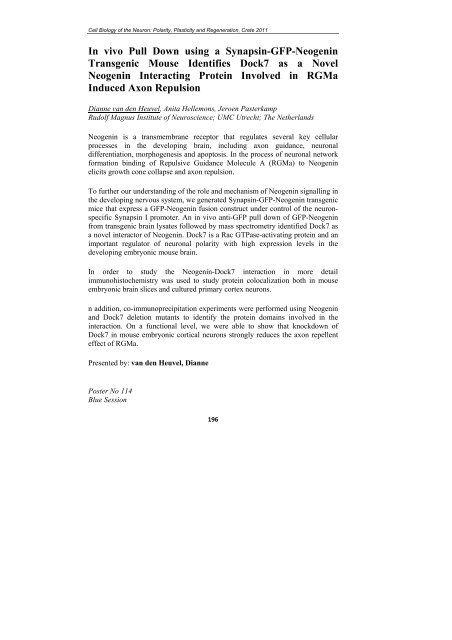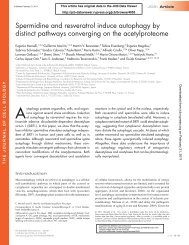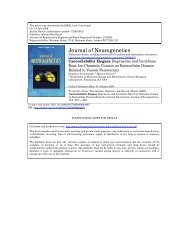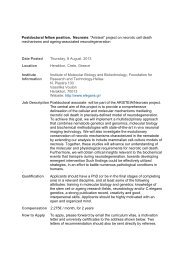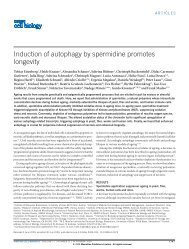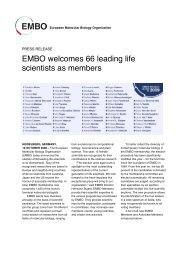CELL BIOLOGY OF THE NEURON Polarity ... - Tavernarakis Lab
CELL BIOLOGY OF THE NEURON Polarity ... - Tavernarakis Lab
CELL BIOLOGY OF THE NEURON Polarity ... - Tavernarakis Lab
You also want an ePaper? Increase the reach of your titles
YUMPU automatically turns print PDFs into web optimized ePapers that Google loves.
Cell Biology of the Neuron: <strong>Polarity</strong>, Plasticity and Regeneration, Crete 2011<br />
In vivo Pull Down using a Synapsin-GFP-Neogenin<br />
Transgenic Mouse Identifies Dock7 as a Novel<br />
Neogenin Interacting Protein Involved in RGMa<br />
Induced Axon Repulsion<br />
Dianne van den Heuvel, Anita Hellemons, Jeroen Pasterkamp<br />
Rudolf Magnus Institute of Neuroscience; UMC Utrecht; The Netherlands<br />
Neogenin is a transmembrane receptor that regulates several key cellular<br />
processes in the developing brain, including axon guidance, neuronal<br />
differentiation, morphogenesis and apoptosis. In the process of neuronal network<br />
formation binding of Repulsive Guidance Molecule A (RGMa) to Neogenin<br />
elicits growth cone collapse and axon repulsion.<br />
To further our understanding of the role and mechanism of Neogenin signalling in<br />
the developing nervous system, we generated Synapsin-GFP-Neogenin transgenic<br />
mice that express a GFP-Neogenin fusion construct under control of the neuronspecific<br />
Synapsin I promoter. An in vivo anti-GFP pull down of GFP-Neogenin<br />
from transgenic brain lysates followed by mass spectrometry identified Dock7 as<br />
a novel interactor of Neogenin. Dock7 is a Rac GTPase-activating protein and an<br />
important regulator of neuronal polarity with high expression levels in the<br />
developing embryonic mouse brain.<br />
In order to study the Neogenin-Dock7 interaction in more detail<br />
immunohistochemistry was used to study protein colocalization both in mouse<br />
embryonic brain slices and cultured primary cortex neurons.<br />
n addition, co-immunoprecipitation experiments were performed using Neogenin<br />
and Dock7 deletion mutants to identify the protein domains involved in the<br />
interaction. On a functional level, we were able to show that knockdown of<br />
Dock7 in mouse embryonic cortical neurons strongly reduces the axon repellent<br />
effect of RGMa.<br />
Presented by: van den Heuvel, Dianne<br />
Poster No 114<br />
Blue Session<br />
196


